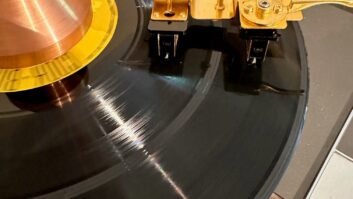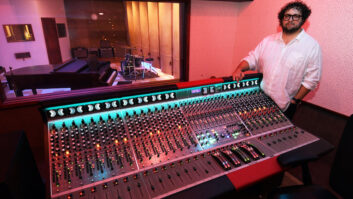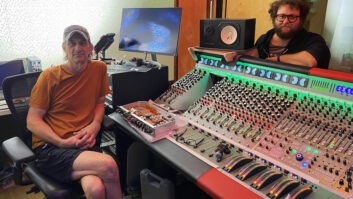Multi-Grammy Award-winning producer, engineer and mixer Neil Dorfsman has worked with the best of the best—Sting, Paul McCartney, Tears For Fears, Bob Dylan, Bruce Springsteen, Def Leppard and Dire Straits, among others. With that track record, he’s obviously captured top-flight guitar sounds over the years. I recently sat down with him to talk shop on mics, preamps, phase and gear, and how he goes about capturing world-class tone.
Q: What would be your two go-to desert island mics for electric guitars?
A: They would likely be the same mics almost everyone uses: the Shure SM57 and a Royer or AEA ribbon. [A dynamic and a ribbon] They will give you two very different and complimentary sonic representations. The ’57 gives you a midrange-y, focused sound [depending partly] on where you place it; the ribbon gives you thickness and warmth in the lower midrange. The ribbon also gives you the smooth sound as it helps “round off” transients.
Q: What would be another mic you might turn to?
A: I might try a condenser, like an AKG 451, with a -20dB pad [engaged], or a Neumann U 87, that will give you a very “hi-fi” sound. A Sennheiser 421 is great, as are Heil mics … or a beyer M160 or Sennheiser 409.
It’s funny—with guitar amps, I do have my go-to microphones but honestly, I’m not all that sure how much difference the mic choices make in the overall sound picture. There are so many variables in guitar recording that the mic may be the least variable in the chain. But the thing is, I know what the mics I choose are supposed to give me, so they eliminate some of the uncertainty and are a bit of a “security blanket” … but I’ve never met anyone who could tell me, by listening, how a guitar was recorded.
Q: How critical is the preamp?
A: I would say it’s pretty critical. I’m someone who likes SSL preamps for guitars; I think that’s where [SSL preamps] shine. I a like them for their focused, midrange quality.
However, whenever I can, I will record with a vintage Neve. I will use them on anything, and everything, at anytime—no questions asked. They are fat, powerful, musical, have that beautiful inherent distortion and are not tweaky.
Q: Why is phase important when it comes to recording guitars?
A: Phase is very important and I’m a bit of a fanatic about it, probably even over the top. Phase is important when you are recording anything, and it’s not just [about] two microphones out of phase with different polarity. To refer to the idea as “absolute phase” [is] when the transient of the sound is accurately translating the transient of the recorded waveform. Now we have the advantage of actually seeing waveforms. If the sound wave is hitting the mic but the electrical impulse is phase-inverted between the mic and your recording medium, the speaker excursion is going to go “in” on the transient, as opposed to “out” on the transient impulse. That will affect the overall sound impression. It is quite difficult to hear in a blind test, but if this is correct across the board, the whole sound is more focused.
Q: What’s the difference between absolute and relative phase?
A: Relative phase can be described as having two microphones receiving the same audio signal, basically, due to time differentials, the wave form at one mic position is on the downward sweep of the signal and at the other position is on its upward sweep. I guess this is “relative acoustic phase—variable versus “fixed” electrical phase—either in or 180 degrees out. Clearly this can be a matter of fractions of inches. Some European mics will be wired differently than US-made microphones.
Therefore, before I start a recording session, I create a Pro Tools session check every mic with a metronome device from the 1980s called Dr. Beat. It’s like a click generator with a speaker and a mini-jack output. I go to every mic and I record each one of them and then make sure that my transients are all correctly being recorded. This simply provides me one less thing to [worry] about for a few reasons. First, I know that all the mics are working properly and sound correct. Second, it allows me to examine absolute phase in my DAW. Third, it’s a great way to “time align” pairs of mics on a single sound source. So—for example, on overheads, I’ll [sit] the Dr. Beat on top of the kick drum, centered, and make sure the levels, phase and timing are all good into the overhead mics. I know it will be different for the snare, but I actually don’t concern myself with that very much. I can always adjust later.
Because of all this, my guitar recording process can be a bit elaborate. I use my Little Labs PCP guitar splitter to distribute the output of the Dr. Beat to multiple amps. Each mic will be going to its own track. I’ll drive the click to each amp and record them all. Then I’ll check it out—zooming in and checking for both absolute phase and time alignment. It’s a bit over the top, but it really works for me.
Q: If something is not in phase, how do you then get it in phase?
A: I physically move the mic. Of course, if it’s time-aligned but “out” of phase, I’ll reverse phase on the mic pre. The Little Labs box also [provides] phase reverse on each of its outputs to each of the amps. Sometimes amps are entirely out of phase with the other amps. So this lets me check relative phase, absolute phase, as well as time alignment between amps.
What I’ve done recently is use the Sound Radix Auto Align plug-in, which tells you how much you have to move any microphone to be in phase with a “master mic.” When you finally get accurate time and phase alignment, guitar amps can sound amazing. It never sounds like three amps—just the greatest single amp ever with all of the different complexities they each might bring.
Once you line this all up, you never move anything—unless the actual cabinet is changed. You can create all of these differing sonic representations without ever going out into the studio again! [Laughs]
Useful Links:
Little Labs PCP:
littlelabs.com/pcp.html
Sound Radix Auto Align Plug-in:
soundradix.com/products/auto-align/







